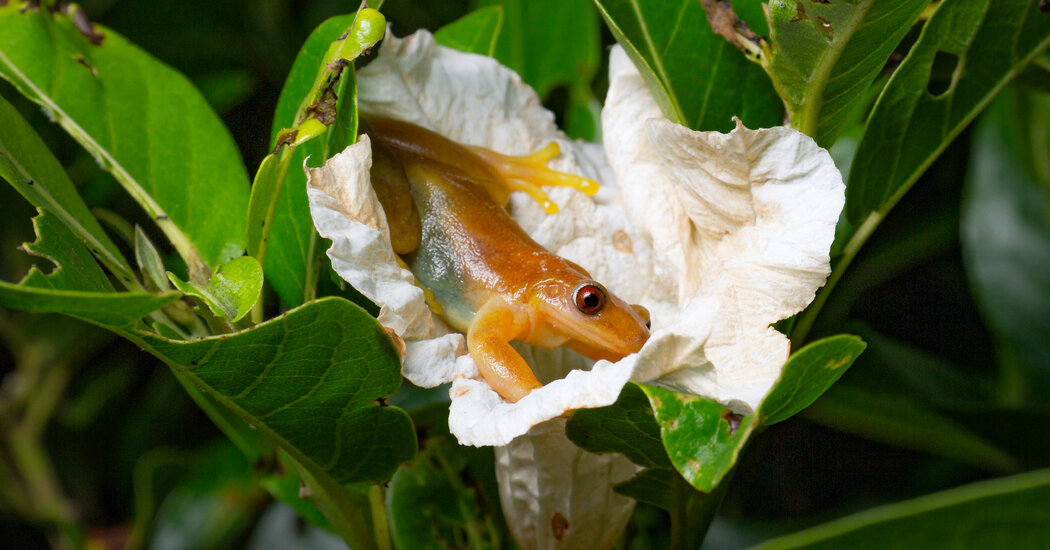On warm evenings near Rio de Janeiro, you might find milk fruit trees covered in brownish-orange frogs. While many frogs eat insects, the tree frog species Xenohyla truncata has a taste for the pulp of bulbous fruits and the nectar in the tree’s flowers.
As they seek that nectar, the frogs dunk their entire bodies into the plant’s flowers, only their butts sticking out. When they emerge, pollen gets stuck to their heads and backs. Then they hop off, potentially transporting the pollen from their previous stop at the tropical buffet into the next milk fruit flower they encounter.
In other words, the frogs may disperse the plant’s seeds and pollinate its flowers — which would be the first time this has been seen in an amphibian.
“That’s completely, completely new, till now, nobody saw them actually doing that,” said Luís Felipe Toledo, head of the Amphibians Natural History Lab at the University of Campinas in Brazil and an author of a study published last month in the journal Food Webs suggesting the existence of this ecological relationship between frog and flowering tree.
“This is a very exciting and intriguing first observation,” said Ruth Cozien, an expert on plant-animal interactions at the University of KwaZulu-Natal in South Africa who was not involved in the study. She said more observations were needed to confirm pollination, but added that the team’s preliminary evidence was “incredible” and “extremely valuable for emphasizing what we can still find if we just look.”
Most frogs are carnivorous, only accidentally snacking on vegetation when it gets in the way while they’re hunting for more critters. But earlier this century, scientists noticed traces of plants in the guts of specimens of Xenohyla truncata, known also as Izecksohn’s Brazilian tree frog. Their examinations suggested the species intentionally and often eats fruits, leaves and flowers, and only seldom preys on insects.
But this behavior was never documented in the wild.
Enter Dr. Toledo’s team, which was performing research in the Restinga forests of eastern Brazil when, at dusk, they stumbled upon plant-loving frogs in action. Much to their surprise, two frogs were spending five to 15 minutes lapping up nectar from inside the bell-shaped flowers.
Because one of the frogs surfaced from its flowery snack clad in pollen, Dr. Toledo said, the team hypothesized that it was “actually very likely” that the species aids milk fruit tree pollination — accidentally taking pollen from flower to flower and causing reproduction — something amphibians weren’t thought to perform. This could also happen with other flowers of similar shapes. In fact, recordings the team made that night show frogs also slurping on nectar from alien bearded irises.
Confirming the discovery could add an amphibian to the surprisingly diverse list of recently discovered pollinators — there are pollinating rats, cockroaches and even lizards. The plethora of pollinators could push the limits of what we understand about relationships between animals and their environment.
But more observations are needed to say the frogs really are pollinating plants.
“We cannot say that these frogs are actually pollinators,” said Felipe Amorim, a pollination ecologist at São Paulo State University who was not involved in the research. “They are flower visitors, they are flower-visitor frogs. We have a lot to learn about this novel interaction.”
For instance, the mucus secreted by the frog’s skin needs to be tested to confirm it doesn’t spoil the pollen before it gets to its destination. Scientists also need to work out whether the pollen is ever delivered to other flowers and if it does successfully fertilize and germinate them. It’s also still unclear why this frog species has developed a liking for flora over fauna in the first place.
As both Xenohyla truncata and the Brazilian milk fruit tree are endangered species, understanding the intricacies of their relationship is imperative for their conservation.
“We are almost losing this kind of special, unique and extraordinary interaction before it can be found,” Dr. Amorim said. “When you lose ecological interactions, it prevents us from discovering many different things about ecosystem functioning in general.”
